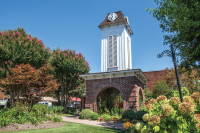For the love of bees: Bee feeding is a pastime with a purpose
 Bees buzz around a feeder at Fred Rovecamp’s home in Balsam. Holly Kays photo
Bees buzz around a feeder at Fred Rovecamp’s home in Balsam. Holly Kays photo
For Ash Rovecamp, keeping honeybees has never been about honey.
“I don’t really consider myself a beekeeper,” he said. “I’m a bee feeder. I hardly even go into my hives, have hardly even gotten honey for myself.”
Instead, he sits on his porch, watches his bees work, and considers how to make their lives happier and healthier. He’s not alone when he does this — 54-year-old Rovecamp, of Sebring, Florida, shares his doublewide with an unspecified number of cats, and it was through his efforts to create supplements and improve the cats’ health that he developed the trial-and-error process he would eventually use to make an herbal mixture that he swears by as an invaluable addition to his bees’ diet.
“At one point I had 30 bowls of food out for the cats with different remedies and herbs,” he said. “I’d let them show me which ones they needed.”
The cats obliged, and Rovecamp wondered if he could use that same approach to figure out a recipe for some bee treats. He began experimenting with adding different mixtures of herbs and oils to the food.
“I had feeders set on every post,” he said. “I just sit out there, watch it and see which ones they go to. You have to break it down, put one herb in each one just like I did with the cats.”
Related Items
Making the tang
Over time, Rovecamp noticed that the bees had preferences not only for particular species of herbs or types of oils but for herbs and oils harvested from specific parts of the plant or originating from specific countries. He spent years perfecting the ratios and ingredients, ending up with a still-evolving recipe that he now calls Bee-TANG — though he insists that the bees are the recipe’s true creators, having chosen its ingredients and proportions under Rovecamp’s watch.
“I am only here to do some legwork,” he said.
Rovecamp declined to name the specific ingredients or state how many ingredients the current recipe contains but said that it’s a mixture of “superfruit herbs and essential oils” hand-selected by the bees and whittled down to “their favoritist of their favoritist.”
“The first rule of Bee-TANG is they have to work it in nature,” he said. “And then the second is that they have to choose it for themselves.”
Rovecamp loves to sit on his porch and watch the swirls of bees rise and fall around the feeder. Bees are all about love, he said. They “wrote the book on” communication and cooperation. They’re some of the planet’s most fascinating creatures.
They’re also some of its most vital, serving a critical role as pollinators for all manner of crops. Rovecamp’s deep conviction about the importance of pollinators and the need to help them in the face of continued obstacles looms large in the motivation for creating Bee-TANG.
“The intent is that the Bee-TANG helps restore the biodiversity that’s kind of been stripped away in nature thanks to civilization and whatnot,” he said.
While he’s not making specific claims about the product, he does see it as helping to “fill the gap.” Anecdotally speaking, Rovecamp can say that despite not receiving any chemical treatment, his Bee-TANG-fed hives are doing “quite well.”
“The premise is that the bees know what they need, and they need the Bee-TANG, and they’ve made that clear — 99.9 percent of the time, they’ll feed it year-round,” said Rovecamp.

Since August, Fred Rovecamp has been feeding bees using an herbal supplement developed by his son Ash. Holly Kays photo

With temperatures in low 60s, activity at the feeder was slow at the time this photo was taken, but during warmer weather attendance is impressive. Holly Kays photo
The Balsam bee buffet
Rovecamp was curious to see how his Bee-TANG experiment would translate to a cooler climate, and as a former resident of Asheville and Waynesville, he immediately thought of Western North Carolina. He sent a feeder and some Bee-TANG to his dad, Waynesville resident Fred Rovecamp, and asked him to give it a try.
“He took to it like a fish to water,” said Ash.
Since August, Fred has been hosting a continuous bee buffet in his backyard in Balsam. On warm days, the bees go through as much as 3 gallons per day, doled out using a poultry feeder surrounded by woodchips, which prevent the bees from drowning in the sweet liquid. For Fred, it’s a joyous relationship.
“I was amazed at how wonderful they are,” said Fred. “You have a dog, and you know how you love that dog? Well, I have that love for these bees.”
There’s something beautiful and hypnotic about watching the bees buzz around the feeder or walk along the woodchips. While they’re absent now that the weather is colder, throughout late summer and into fall they were Fred’s constant companions.
“I look forward to getting up before daybreak in the warm weather and putting that feeder out and checking them during the day and seeing how they’re doing,” he said.
Fred and Ash both hope that if people across the country were to follow suit, if bee feeding were to become as commonplace as bird feeding, there could be a real turnaround in the global crisis that pollinators — not just bees — are facing.
Globally, pollinator species are in decline due to a confluence of causes. They have less space to forage due to various types of human development. Non-native plant species often fail to provide native pollinators with the food sources they’re adapted to use, and non-native pollinators can compete with native species for limited pollen and nectar sources. Pesticides, climate change, parasites and disease are having an impact too. Honeybees have been extremely hard hit.
Concern about pollinator populations is more than academic. According to the USDA Natural Resource Conservation Service, three-quarters of the world’s flowering plants and about 35 percent of the world’s food crops depend on pollinators to produce. If people are to keep eating, pollinators need to keep pollinating.
Bee feeding, said Ash, is a “gateway” for people to learn more about bees and become part of the solution.
“The funny part is, we think we’re helping the bees, which is good and we are, but they’re really the ones that are going to help us, and are helping us now,” he said.
Making a difference
David Tarpy, professor and extension apiculturist at N.C. State University, is skeptical as to whether individual people putting out bee feeders can have much impact on overall honeybee health, simply because a colony needs a large volume of honey to make it through the winter — 35 to 100 pounds. Additionally, he said, large trough feeding that brings big groups of bees from different colonies together can foster disease spread and aggressive behavior.
However, when it comes to native pollinator species — of which there are more than 4,000 in North America — bee feeding can make a huge difference, he said.
“That could make the difference between one versus two baby bees for a single solitary mother bee,” said Tarpy. “Every little bit helps.”
While Bee-TANG was created specifically for honeybees, said Ash, it does attract some other pollinators as well.
Supplemental feeding is not the only way to support pollinators. Planting native flowering species, especially ones that bloom in the less flowery seasons of early spring, midsummer and fall, goes a long way toward improving things for these species. Alternatively, don’t plant anything at all. Instead, stop mowing and allow the yard to run wild with clover, asters, dandelions and whatever other bee-friendly blooms might pop up.
“If we could change our mindset of having weedy lawns as being attractive, and something that’s good, that will go a really, really long way to help the pollinators instead of having these food deserts where all the flowering plants are killed off with herbicide,” he said.
However, Tarpy said, there has been remarkably little research done into the type of supplemental feeding that Rovecamp conducts.
“Supplementing them with something is better than them starving, so I think there’s a lot of obvious benefits of having food versus no food,” he said. “But to have this type of food over this type of food — there just hasn’t been a whole lot of empirical study on that. Surprisingly so, compared to a lot of other livestock systems.”
That’s partly because it’s a hard thing to study. Each hive is home to tens of thousands of bees, with workers flying up to 3 miles away in search of food. It’s hard to keep track of exactly which bee is eating exactly which food and then to relate that to a health outcome for the individual or the hive as a whole.
That said, many beekeepers offer their bees some extra food during times of the year when there may not be enough blooms around to keep them full — usually early spring, mid-summer and late fall. It’s unusual for a beekeeper to offer supplemental feed year-round, as Rovecamp does.
It’s also true that bees’ diets aren’t just about calories.
“It’s about the types of calories,” Tarpy explained. “Honeybees need a balance of different resources in order to make sure that those macro and micronutrients are optimized for their health.”
Just as human bodies require a varied diet to stay healthy, honeybees also require a diversity of food sources to thrive. While there hasn’t been much research into supplement recipes, the science is clear on the importance of biodiversity.
“Nutrition definitely is one of those factors that we know can lead to colonies dying off or otherwise not being as healthy as they could be,” Tarpy said. “It’s been shown, for example, that their immune systems are boosted when they have diversity of floral resources. They grow better. They have a higher chance of survival.”
And in the long run, so do we.









